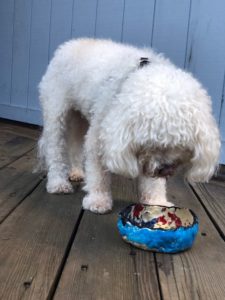As promised, here is a more expansive look at the overall topic of food for your pets – what food should have, what it shouldn’t have, things to look out for, and tips for making your own food at home!
A good place to start is with the components of a healthy pet diet – what do pets need in their food to thrive?
First and foremost is the nutritional component of the food, which should come as no surprise. Dogs and cats need to make sure that they’re getting the proper nutrients they need every day – pets have similar nutritional needs as humans (high in protein and fat with supplemental carbohydrates for energy, and a healthy balance of vitamins and minerals). Make no mistake though, this does NOT mean they can eat the same diet as a human!
Caloric intake is also incredibly important to monitor for your pets, especially if you are cooking for them yourself (more on that later). Pets have very specific metabolisms that are different from that of humans, and need to adjust accordingly:
- Dogs, on average, need about 30 calories / lb of body weight per day to maintain their current weight
- Small, active dogs less than 20 lbs can use up to 40 calories / lb per day
- Large dogs, over 50 lbs, can use as little as 20 calories / lb per day
- Indoor cats, on average, need about 20 calories / lb to maintain their weight
- Outdoor only cats should have 35 calories / lb to maintain
- Indoor / outdoor mix cats fall somewhere in between 20 and 35 depending on level of activity
Calorie calculator for cats can be found here, and a calorie calculator for dogs here.
Now that we’ve covered the building blocks of what your pet’s diet is based on, you can dole out your pet food with care to maintain your pet’s healthy weight. The question is – what food should you buy? There’s countless brands of food out there for your pet, from the everpresent cheap stuff to high quality, well sourced brands. It’s difficult to wade through all of these in one post, but I’ll share an insight from VCA as a part of their helpful guidelines on pet nutrition: “Feed your [pets] the highest-quality food you can afford.”
To explore why pet food is not the monthly expense you should be pinching pennies on, let’s explore some of the pratfalls of the pet food industry and what this can mean for your pet.

This 2015 study by the AVMA shows that 40% of food contains different meats than what is advertised on the label. Testing 52 foods, including wet, dry, and treats, 13 contained species not advertised, 4 were missing meats advertised, and 3 foods had both problems.
The study was conducted as a response to the 2013 UK scandal where restaurants were exposed for using horse meat in their meals without advertising it. The problem is reflective in what we give our pets – why spend money on pet food if we’re going to be giving them unidentified meat that could disagree with them or worse make them sick?
The AVMA clarified in their study that mislabeling in pet foods is not often seen as deliberate, but more of a problem from up the supply chain, the cause of formulation errors or miscommunications from suppliers.
There have been many recalls in the pet food industry over the past few years, from a variety of causes. Bacteria is the most prominent, but recalls have been the result of chemical or natural contaminants in food, as well as formulation errors. In 2007, the FDA found melamine in food that was sickening and killing cats and dogs!
The reason for the prominence of recalls lately are not because there are no trustworthy foods for a pet, but more if there is any kind of formulation error or mislabeling, the FDA wants to catch it early. To ease your mind, less than 2% of animal poisonings are food related.
What is a concerned pet owner to do? Again, buying your pets the highest quality food you can afford them is a great way to avoid these problems. Say, however, you’ve had enough of having to worry, and want to start home cooking food for your pets! It’s very possible, but there are many considerations involved.
Home cooked pet diets can also be a great way to be able to feed a pet with skin allergies, intolerances, and other difficulties that can come with store bought food. Let’s break it down into common healthy components for dogs, and then cats:
Dogs:
- Boneless, skinless, unseasoned lean turkey or chicken
- Ground or cubed beef
- Boiled pasta, no sauce
- Lettuce
- Most raw or steamed vegetables (absolutely no onions!)
- Boiled potatoes (the more color to the potato, i.e. red or purple, the healthier)
- Peanut butter (make sure to go organic to minimize sugar and additives – none if possible please!)
- Scrambled or hardboiled eggs (must be given sparingly to avoid cholesterol buildup)
- Cheese (nothing spicy or seasoned)
Cats:
- Lean animal protein, usually chicken or fish (must be 100% boneless, shellfish / clams can be a good substitute if this is impossible)
- Rice
- The above two components will cover most everything, but make sure if you’re feeding your cat homemade food to add some neutral oil such as vegetable, bonemeal tablets, and vitamin supplements to keep their diet balanced!
This should be a good place to start when preparing meals for pets. Please make sure to research thoroughly if you choose to go through with this – every pet is different and can handle different foods!
A big trend in recent years has been to put pets on a raw diet – this can be an option for some but precautions must be taken. The AVMA discourages the use of raw animal protein in dog and cat diets unless it has been subjected to the complete elimination of pathogens like salmonella and campylobacter. This can be no easy feat, and for that reason it’s discouraged to feed your pet any raw:
- Eggs
- Chicken
- Turkey
- Beef
- Pork
- Sheep
- Fish
- Deer
- Buffalo
- Unpasteurized milk
If you want to find a way to meet in the middle, its possible to purchase air dried / dehydrated food for pets that can provide more nutrients than cooked food and is far more digestible to pets than a raw diet.
Grain free dog diets have also been growing exponentially in popularity over the last few years. Much like raw diets, they can provide a way for dogs with food allergies to eat healthily. They can also provide a dog with more energy, a healthier skin and coat, and better breath. However, the FDA has released a study linking grain free diets to a specific disorder in dogs called Canine Dilated Cardiomyopathy (DCM).
Foods involving legumes, such as peas and lentils are thought to be causing the problem. The link was discovered somewhat unusually, as DCM is not rare in dogs, but was showing in breeds of dogs not usually prone to DCM.
DCM is caused by thinning of the ventricular wall, and often manifests in all four chambers of the heart. This diminishes the heart’s ability to pump blood, causing lethargy, collapse, exhaustion, and even congestion of blood in the lungs. It can be treated by trying to increase the heart’s systolic pump pressure.
 DCM is usually seen in big dogs such as Doberman pinschers, Great Danes, Newfoundlands, Irish Wolfhounds, and Saint Bernards. Some small dogs such as English and American Cocker Spaniels also show a higher likelihood for DCM. In the case of grain free diets, atypical cases were manifesting, such as DCM in Labrador and Golden Retrievers, Whippets, Bulldogs, and Shih Tzus. The problem is thought to be linked to all types of grain free food, mostly dry, but including wet, semi moist, and raw.
DCM is usually seen in big dogs such as Doberman pinschers, Great Danes, Newfoundlands, Irish Wolfhounds, and Saint Bernards. Some small dogs such as English and American Cocker Spaniels also show a higher likelihood for DCM. In the case of grain free diets, atypical cases were manifesting, such as DCM in Labrador and Golden Retrievers, Whippets, Bulldogs, and Shih Tzus. The problem is thought to be linked to all types of grain free food, mostly dry, but including wet, semi moist, and raw.
There’s truly much more to consider to feeding your pets than just picking a bag off of a shelf! If you want your pet to be happy, healthy, and active, the food is the first step in line. Don’t get too overwhelmed though – the concept is simple. Do your research, feed your pets adequate portions of healthy, high quality food, pay attention to how your pet responds, and you should be set!

